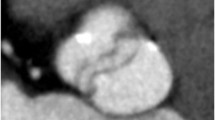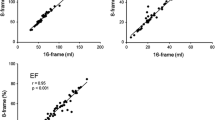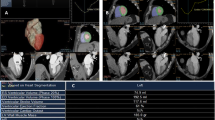Abstract
Left ventricular (LV) volumes, ejection fraction (LVEF) and regional wall motion (LVRWM) have important treatment and prognostic implications in patients with coronary artery disease. We sought to determine the accuracy of 320-row multidetector computed tomography (MDCT) for the assessment of LV volumes, LVEF and LVRWM, using 2D-echocardiography as the reference standard. We evaluated 50 consecutive patients (mean age 60 ± 14 years, 66% male) who underwent 320-detector MDCT (dose-modulated retrospective electrocardiogram-triggering) and 2D-echocardiography within 14 days for investigation of known or suspected coronary artery disease. Two blinded readers measured LV volumes on MDCT and visually assessed LVRWM with a 3-point scale using a 17-segment model. A separate experienced echocardiologist, blinded to MDCT findings, assessed LVRWM on 2D-echocardiograms and determined LV volumes and LVEF using Simpson’s biplane method. 2D-echocardiography served as the reference standard. Mean LVEF was 59 ± 9% (range 26–75%) on 2D-echocardiography and 60 ± 9% (range 27–76%) on MDCT. Using linear regression analysis, MDCT agreed very well with 2D-echocardiography for assessment of LVEDV (r2 = 0.88; P < 0.001), LVESV (r2 = 0.95; P < 0.001) and LVEF (r2 = 0.90; P < 0.001). Mean differences (±standard deviation) of 14 ± 13 ml, 5 ± 7 ml and 1 ± 3% were observed between MDCT and 2D-echocardiography for LVEDV, LVESV and LVEF, respectively. On 2D-echocardiography, 81/850 (9.5%) segments had abnormal LVRWM. Agreement for assessment of LVRWM between 2D-echocardiography and MDCT was excellent (96%, k = 0.76). Accurate assessment of LV volumes, LVEF and LVRWM is feasible with 320-detector MDCT, with MDCT demonstrating slightly larger LV volumes than 2D-echocardiography.




Similar content being viewed by others
References
White HD, Norris RM, Brown MA, Brandt PW, Whitlock RM, Wild CJ (1987) Left ventricular end-systolic volume as the major determinant of survival after recovery from myocardial infarction. Circulation 76:44–51
Emond M, Mock MB, Davis KB et al (1994) Long-term survival of medically treated patients in the coronary artery surgery study (CASS) registry. Circulation 90:2645–2657
Schwammenthal E, Adler Y, Amichai K et al (2003) Prognostic value of global myocardial performance indices in acute myocardial infarction: comparison to measures of systolic and diastolic left ventricular function. Chest 124:1645–1651
Hunt SA, Abraham WT, Chin MH et al (2009) 2009 focused update incorporated into the ACC/AHA 2005 guidelines for the diagnosis and management of heart failure in the adults: a report of the American College of Cardiology Foundation/American Heart Association Task Force on Practice Guidelines. Circulation 119:e391–e479
Yamamuro M, Tadamura E, Kubo S et al (2005) Cardiac functional analysis with multi-detector row CT and segmental reconstruction algorithm: comparison with echocardiography, SPECT, and MR imaging. Radiology 234:381–390
Cury RC, Nieman K, Shapiro MD (2007) Comprehensive cardiac CT study: evaluation of coronary arteries, left ventricular function, and myocardial perfusion—is it possible? J Nucl Cardiol 14:229–243
Steigner ML, Otero HJ, Cai T et al (2009) Narrowing the phase window width in prospectively ECG-gated single heart beat 320-detector row coronary CT angiography. Int J Cardiovasc Imaging 25:85–90
Dewey M, Muller M, Eddicks S et al (2006) Evaluation of global and regional left ventricular function with 16-slice computed tomography, biplane cineventriculography, and two-dimensional transthoracic echocardiography: comparison with magnetic resonance imaging. J Am Coll Cardiol 48:2034–2044
Henneman MM, Schuijf JD, Jukema JW et al (2006) Assessment of global and regional left ventricular function and volumes with 64-slice MSCT: a comparison with 2D echocardiography. J Nucl Cardiol 13:480–487
Ko SM, Kim YJ, Park JH, Choi NM (2010) Assessment of left ventricular ejection fraction and regional wall motion with 64-slice multidetector CT: a comparison with two-dimensional transthoracic echocardiography. Br J Radiol 83:28–34
Schuijf JD, Bax JJ, Jukema JW et al (2007) Assessment of left ventricular volumes and ejection fraction with 16-slice multi-slice computed tomography; comparison with 2D-echocardiography. Int J Cardiol 116(2):201–205
Schepis T, Gaemperli O, Koepfli P et al (2006) Comparison of 64-slice CT with gated SPECT for evaluation of left ventricular function. J Nucl Med 47(8):1288–1294
Rybicki FJ, Otero HJ, Steigner ML et al (2008) Initial evaluation of coronary images from 320-detector row computed tomography. Int J Cardiovasc Imaging 24(5):535–546
Kitagawa K, Lardo AC, Lima JAC, George RT (2009) Prospective ECG-gated 320 row detector computed tomography: implications for CT angiography and perfusion imaging. Int J Cardiovasc Imaging 25:201–208
Hausleiter J, Meyer T, Hermann F et al (2009) Estimated radiation dose associated with cardiac CT angiography. JAMA 301(5):500–507
de Jonge GJ, van Ooijen PMA, van der Vleuten PA et al (2009) The reliability of automatic measurement of left ventricular function with dual-source computed tomography datasets. Eur Radiol 19:2919–2930
Cerqueira MD, Weissman NJ, Dilsizian V et al (2002) Standardized myocardial segmentation and nomenclature for tomographic imaging of the heart: a statement for healthcare professionals from the Cardiac Imaging Committee of the Council on Clinical Cardiology of the American Heart Association. Circulation 105:539–542
Schiller NB, Acquatella H, Ports TA et al (1979) Left ventricular volume from paired biplane two-dimensional echocardiography. Circulation 60:547–555
Bland JM, Altman DG (1986) Statistical methods for assessing agreement between two methods of clinical measurement. Lancet 1:307–310
de Graaf FR, Schuijf JD, van Velzen JE et al (2010) Assessment of global left ventricular function and volumes with 320-row multidetector computed tomography: a comparison with 2D-echocardiography. J Nucl Cardiol 17:225–231
Butler J, Shapiro MD, Jassal D et al (2007) Comparison of multidetector computed tomography and two-dimensional transthoracic echocardiography for left ventricular assessment in patients with heart failure. Am J Cardiol 99:247–249
Lessick J, Mutlak D, Rispler S et al (2005) Comparison of multidetector computed tomography versus echocardiography for assessing regional left ventricular function. Am J Cardiol 96:1011–1015
Salm LP, Schuijf SD, de Roos A et al (2006) Global and regional left ventricular function assessment with 16-detector row CT: comparison with echocardiography and cardiovascular magnetic resonance. Eur J Echocardiogr 7:308–314
Abbarra S, Chow BJ, Pena AJ et al (2008) Assessment of left ventricular function with 16- and 64-slice multi-detector computed tomography. Eur J Radiol 67:481–486
Juergens KU, Seifarth H, Range F et al (2008) Automated threshold based 3D segmentation versus short-axis planimetry for assessment of global left ventricular function with dual-source MDCT. AJR 190:308–314
Sugeng L, Mor-Avi V, Weinert L et al (2006) Quantitative assessment of left ventricular size and function: side-by-side comparison of real-time three-dimensional echocardiography and computed tomography with magnetic resonance reference. Circulation 114:654–661
Jenkins C, Bricknell K, Hanekom L, Marwick TH (2004) Reproducibility and accuracy of echocardiographic measurements of left ventricular parameters using real-time three-dimensional echocardiography. J Am Coll Cardiol 44:878–886
Conflict of interest
None.
Author information
Authors and Affiliations
Corresponding author
Rights and permissions
About this article
Cite this article
Nasis, A., Moir, S., Seneviratne, S.K. et al. Assessment of left ventricular volumes, ejection fraction and regional wall motion with retrospective electrocardiogram triggered 320-detector computed tomography: a comparison with 2D-echocardiography. Int J Cardiovasc Imaging 28, 955–963 (2012). https://doi.org/10.1007/s10554-011-9906-2
Received:
Accepted:
Published:
Issue Date:
DOI: https://doi.org/10.1007/s10554-011-9906-2




